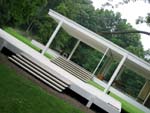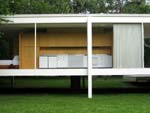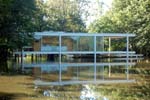
|

|
|
Home Site Search Contact Us Subscribe
|
|
|
Move the Farnsworth House Mies built the Farnsworth in spitting distance of the mighty Fox River, and the house is paying a price for his hubris. By Fred Bernstein May 25, 2010 The house Ludwig Mies van der Rohe designed for Edith Farnsworth, 60 miles southwest of Chicago, deserves the overused term “icon.” Only one other 20th-century house – Frank Lloyd Wright’s Fallingwater – has been as influential.
In 2004, preservationists fought a battle to save the house, which its then-owner, the real estate developer and architecture buff Peter Palumbo, had decided to sell. Preservationists were outraged by the possibility of a collector picking up the house and moving it to, say, East Hampton or Beverly Hills. Mies’s creation, they said, needed to remain in its intended setting.
They were half right. The house is part of the architectural heritage of the greater Chicago area – Mies is a key figure in that city’s development – and would make no more sense to move it to California than it would to ship the Hollywood sign to the shores of Lake Michigan.
But does that mean it shouldn’t be moved at all? Mies built the Farnsworth in spitting distance of the mighty Fox River, and the house is paying a price for his hubris. It has been flooded at least four times (three of them in the last 13 years). The most recent flood, in September 2008, caused at least $500,000 in damage, mostly to interior woodwork. But the cumulative effect of the periodic flooding is worse. Steel window frames are rusting inside the house, where water was never meant to reach.
Whitney French, the indefatigable director of the Farnsworth House (which is run by the National Trust for Historical Preservation), has explored ideas for protecting the house from future floods. Proposals included using a helicopter to raise the house into the air when necessary, or installing glass walls that would rise out of the ground around the house – a kind of “reverse fish tank.” Neither idea is practical.
In the meantime, French’s high-tech tools for protecting the house include plastic milk crates, duct tape and heavy-duty trash bags: When the river rises, she boards a 6-foot skiff, paddles out, and begins a frantic effort to raise the house’s contents off the floor. The building itself remains in harm’s way.
Mies was aware of the flooding problem; in fact, some architectural historians believe Mies chose the location that would give him the best excuse for raising the house off the ground, satisfying a predisposition for an elevated plinth. Indeed, to a typical adult standing on the lawn in front of the house, the floor plane disappears, and the house is perceived as a façade – an astonishing apotheosis of the minimalist ideal.
But that would still be true if the house were moved to higher ground. And it should be: The Farnsworth site encompasses some 60 acres, sloping up from the river. The house’s current elevation is 564 feet. But parts of the site rise to 580 feet – and no recorded flood has surpassed 575 feet.
It’s too late to argue that the house has to be seen precisely in its original context. After all, the site has changed markedly since 1951, when the building was completed. Back then, the house sat in a meadow; a famous photograph by George Nelson shows Dr. Farnsworth with the grass up to her shoulders. Another notable feature of the site was a giant black sugar maple, thought to be more than 100 years old, whose branches provided a thrilling naturalistic counterpoint to Mies’s right-angled composition.
But, the meadow is now a lawn, thanks to Palumbo. And the tree is largely dying – its most prominent branch, seen in virtually every famous photo of the house, is gone.
Worse, in 1969, the State of Illinois (after using its power of eminent domain to obtain a slice of the Farnsworth property) built a bridge over the river only 100 yards from the house (fly to 14520 River Rd, Plano, IL 60545, on Google Earth, to see it). The sound of traffic across the bridge is a constant even in summer, when the trees are thick with leaves; in winter, with the trees bare, drivers can see the house from the bridge, and they honk their horns in recognition.
The views Mies intended, both of the house and from the house, have changed, irreparably. Maintaining the original house-to-site relationship is no longer possible.
True, Mies situated the house so that, to someone standing in the living room, the view was 1/3 foreground (lawn), 1/3 middle ground (river and trees), and 1/3 background (sky), a tableau as perfectly composed as any painting. That would be lost if the house were moved farther from the river (where the swimming pool, built by Lord Palumbo, would be a poor stand-in for the river).
For that reason and others, French opposes the idea of taking the house to higher ground. She wrote in an e-mail that “the proportions are critical from both the exterior and the interior and that often our human intervention can be more threatening than Mother Nature’s.”
Perhaps. But the Farnsworth House is a work of man – not nature – and it is man who can make the rational choice to move it up the hill to safety.
Fred Bernstein has written about design for more than 15 years. He contributes to the New York Times, Metropolis, Architect, Architectural Record, and other publications.
Click here to read more by Bernstein on ArchNewsNow. |
(click on pictures to enlarge)  Fred Bernstein Farnsworth House by Mies van der Rohe, 1951  Fred Bernstein View into the galley kitchen  Tigerhill Studio Bucolic setting by the Fox River...  LPCI ...with wonderful river views  National Trust for Historical Preservation Until the river rises...  Landmarks Illinois ...and rises some more |
© 2010 ArchNewsNow.com